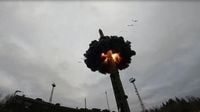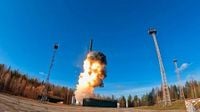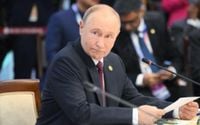In a dramatic week marked by saber-rattling and diplomatic uncertainty, Russia showcased its formidable nuclear arsenal in a series of high-profile military drills, even as a much-anticipated summit between U.S. President Donald Trump and Russian President Vladimir Putin was abruptly put on hold. The events, unfolding amid the ongoing conflict in Ukraine, have sent ripples through global power corridors and underscored the precarious state of U.S.-Russia relations.
On Wednesday, October 22, 2025, President Vladimir Putin personally supervised comprehensive exercises of Russia’s Strategic Nuclear Forces. According to Military Watch Magazine, these drills involved all three elements of the so-called nuclear triad: land-based intercontinental ballistic missiles (ICBMs), submarine-launched ballistic missiles (SLBMs), and strategic bombers. The Russian Defense Ministry revealed that the drills featured practical launches of both intercontinental and cruise missiles, with the stated aim of evaluating the operational readiness of military command structures.
The technical scope of the drills was impressive by any standard. A RS-24 Yars ICBM—also known as Topol-MR, with NATO designations SS-29 or SS-27 Mod—was launched from the Plesetsk State Cosmodrome in northwestern Russia, traveling 6,000 kilometers (approximately 3,700 miles) to its target at the Kura training ground in Kamchatka, on the country’s far eastern edge. The Yars missile, a three-stage solid-fuel ICBM, is capable of carrying up to four multiple independently targetable warheads (MIRVs) and boasts a maximum range of 11,000 to 12,000 kilometers (6,800 to 7,500 miles), according to The Economic Times.
Meanwhile, from the icy waters of the Barents Sea, the nuclear-powered submarine Bryansk launched a R-29RMU2 Sineva missile. The Sineva, a three-stage liquid-propellant SLBM, can carry between four and ten MIRVs and has a maximum range exceeding 8,300 kilometers (over 5,150 miles). The drills also included Tu-95 strategic bombers releasing long-range cruise missiles, rounding out the triad’s demonstration of force.
The Kremlin emphasized that these exercises had been planned in advance. Yet, their timing—coinciding with the indefinite postponement of the Trump-Putin summit—was impossible to ignore. Sitting alone at a round white table, Putin watched the proceedings via big screens displaying General Valery Gerasimov, Chief of the General Staff, and Defense Minister Andrei Belousov. As reported by Military Watch Magazine and The Economic Times, Gerasimov briefed Putin via video link, stating that the drills were intended to "practice procedures for authorizing the use of nuclear weapons." The command chain, as highlighted in Military Watch Magazine, involved Putin at the helm, with Gerasimov and Belousov as the key figures in the nuclear weapons deployment protocol.
The global significance of these drills was not lost on international observers. Military Watch Magazine asserted that Russia’s strategic nuclear triad "surpasses all global rivals in major parameters," maintaining what it called "full parity" with the United States and shaping the balance of power worldwide. The publication went so far as to describe Russia’s land-based and naval nuclear capabilities as the cornerstone of its strategic deterrence and a fundamental element in maintaining global stability.
While the missiles were flying, diplomatic efforts were stalling. Just a week earlier, Trump had announced plans to meet Putin in Budapest, Hungary, in hopes of brokering some kind of progress on Ukraine. But on Tuesday, October 21, the U.S. president abruptly canceled the summit, citing a lack of meaningful movement from Moscow. "We canceled the meeting with President Putin—it just didn’t feel right to me. It didn’t feel like we were going to get to the place we have to get. So I canceled it, but we’ll do it in the future," Trump told reporters, according to Reuters and The Economic Times. He added, "Every time I speak to Vladimir, I have good conversations and then they don't go anywhere. They just don't go anywhere."
The decision to postpone the summit followed a Monday call between U.S. Secretary of State Marco Rubio and Russian Foreign Minister Sergey Lavrov. Lavrov made it clear that Russia was not ready to endorse an immediate ceasefire in Ukraine, a stance that left little room for optimism in Washington. Kremlin spokesman Dmitry Peskov emphasized that both leaders "are accustomed to working efficiently with high productivity," but that "effectiveness always requires preparation." As Peskov put it, "No one wants to waste time: neither President Trump nor President Putin."
Against this tense backdrop, the Trump administration took a decisive step on Wednesday, announcing a new round of sanctions targeting Russia’s two largest oil companies, Rosneft and Lukoil. It was the first time since taking office as the 47th President of the United States that Trump had imposed such direct measures against Moscow. In a statement, Treasury Secretary Scott Bessent declared, "Given President Putin’s refusal to end this senseless war, Treasury is sanctioning Russia’s two largest oil companies that fund the Kremlin’s war machine." The move was intended to ratchet up economic pressure on Moscow and force Putin back to the negotiating table for a ceasefire and eventual peace deal in Ukraine.
Europe, too, responded with fresh measures, as the European Union imposed its first-ever ban on imports of Russian liquefied natural gas (LNG), effective January 1, 2027. This unprecedented step signaled growing frustration in Western capitals over the protracted conflict and Russia’s continued military aggression.
Meanwhile, the situation on the ground in Ukraine remained dire. Russian drones pummeled several buildings in Kiev on Wednesday night, following a barrage a day earlier, while missiles struck targets in various Ukrainian cities. The relentless attacks underscored the urgency of diplomatic efforts and the high stakes involved in any negotiation between Washington and Moscow.
Throughout 2025, Trump’s approach to the Ukraine crisis has been anything but static. He has oscillated between calls for immediate ceasefires and suggestions that Ukraine might eventually reclaim territory lost during nearly four years of fighting. This shifting stance has left both allies and adversaries uncertain about the future of U.S. policy in the region.
In the end, the convergence of nuclear drills and diplomatic deadlock paints a stark picture of the current state of U.S.-Russia relations. The Russian military’s show of strength—meticulously overseen by Putin and his top generals—sent a clear message: Moscow remains a formidable nuclear power, ready to assert its interests on the world stage. At the same time, the collapse of the Budapest summit and the imposition of new sanctions reveal just how far apart the two sides remain on the path to peace in Ukraine.
For now, the world watches as missiles are tested and summits are shelved, hoping that cooler heads will prevail before the next crisis erupts.


